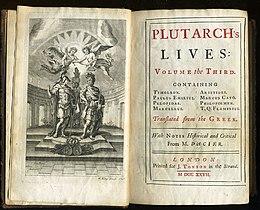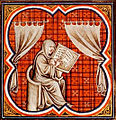Portal:Biography
The Biography Portal

A biography, or simply bio, is a detailed description of a person's life. It involves more than just basic facts like education, work, relationships, and death; it portrays a person's experience of these life events. Unlike a profile or curriculum vitae (résumé), a biography presents a subject's life story, highlighting various aspects of their life, including intimate details of experience, and may include an analysis of the subject's personality.
Biographical works are usually non-fiction, but fiction can also be used to portray a person's life. One in-depth form of biographical coverage is called legacy writing. Works in diverse media, from literature to film, form the genre known as biography.
An authorized biography is written with the permission, cooperation, and at times, participation of a subject or a subject's heirs. An autobiography is written by the person themselves, sometimes with the assistance of a collaborator or ghostwriter. (Full article...)
Featured biographies –
Homer Calvin Davenport (1867 – May 2, 1912) was a political cartoonist and writer from the United States. He is known for drawings that satirized figures of the Gilded Age and Progressive Era, most notably Ohio Senator Mark Hanna. Although Davenport had no formal art training, he became one of the highest paid political cartoonists in the world. Davenport also was one of the first major American breeders of Arabian horses and one of the founders of the Arabian Horse Club of America.
A native Oregonian, Davenport developed interests in both art and horses as a young boy. He tried a variety of jobs before gaining employment as a cartoonist, initially working at several newspapers on the West Coast, including The San Francisco Examiner, purchased by William Randolph Hearst. His talent for drawing and interest in Arabian horses dovetailed in 1893 at the Chicago Daily Herald when he studied and drew the Arabian horses exhibited at the World's Columbian Exposition. When Hearst acquired the New York Morning Journal in 1895, money was no object in his attempt to establish the Journal as a leading New York newspaper, and Hearst moved Davenport east in 1885 to be part of what is regarded as one of the greatest newspaper staffs ever assembled. Working with columnist Alfred Henry Lewis, Davenport created many cartoons in opposition to the 1896 Republican presidential candidate, former Ohio governor William McKinley, and Hanna, his campaign manager. McKinley was elected and Hanna elevated to the Senate; Davenport continued to draw his sharp cartoons during the 1900 presidential race, though McKinley was again victorious. (Full article...)

Lindow Man, also known as Lindow II and (in jest) as Pete Marsh, is the preserved bog body of a man discovered in a peat bog at Lindow Moss near Wilmslow in Cheshire, North West England. The remains were found on 1 August 1984 by commercial peat cutters. Lindow Man is not the only bog body to have been found in the moss; Lindow Woman was discovered the year before, and other body parts have also been recovered. The find was described as "one of the most significant archaeological discoveries of the 1980s" and caused a media sensation. It helped invigorate the study of British bog bodies, which had previously been neglected.
Dating the body has proven problematic, but it is thought that he was deposited into Lindow Moss, face down, sometime between 2 BC and 119 AD, in either the Iron Age or Romano-British period. At the time of death, Lindow Man was a healthy male in his mid-20s, and may have been of high social status as his body shows little evidence of having done heavy or rough physical labour during his lifetime. There has been debate over the reason for his death; his death was violent and perhaps ritualistic. (Full article...)
Nathaniel Parker Willis (January 20, 1806 – January 20, 1867), also known as N. P. Willis, was an American writer, poet and editor who worked with several notable American writers including Edgar Allan Poe and Henry Wadsworth Longfellow. He became the highest-paid magazine writer of his day. His brother was the composer Richard Storrs Willis and his sister Sara wrote under the name Fanny Fern. Harriet Jacobs wrote her autobiography while being employed as his children's nurse.
Born in Portland, Maine, Willis came from a family of publishers. His grandfather Nathaniel Willis owned newspapers in Massachusetts and Virginia, and his father Nathaniel Willis was the founder of Youth's Companion, the first newspaper specifically for children. Willis developed an interest in literature while attending Yale College and began publishing poetry. After graduation, he worked as an overseas correspondent for the New York Mirror. He eventually moved to New York and began to build his literary reputation. Working with multiple publications, he was earning about $100 per article and between $5,000 and $10,000 per year. In 1846, he started his own publication, the Home Journal, which was eventually renamed Town & Country. Shortly after, Willis moved to a home on the Hudson River where he lived a semi-retired life until his death in 1867. (Full article...)

Sir Arthur John Gielgud, OM, CH (/ˈɡiːlɡʊd/ GHEEL-guud; 14 April 1904 – 21 May 2000) was an English actor and theatre director whose career spanned eight decades. With Ralph Richardson and Laurence Olivier, he was one of the trinity of actors who dominated the British stage for much of the 20th century. A member of the Terry family theatrical dynasty, he gained his first paid acting work as a junior member of his cousin Phyllis Neilson-Terry's company in 1922. After studying at the Royal Academy of Dramatic Art (RADA), he worked in repertory theatre and in the West End before establishing himself at the Old Vic as an exponent of Shakespeare in 1929–31.
During the 1930s Gielgud was a stage star in the West End and on Broadway, appearing in new works and classics. He began a parallel career as a director, and set up his own company at the Queen's Theatre, London. He was regarded by many as the finest Hamlet of his era, and was also known for high comedy roles such as John Worthing in The Importance of Being Earnest. In the 1950s Gielgud feared that his career was threatened when he was convicted and fined for a homosexual offence, but his colleagues and the public supported him loyally. When avant-garde plays began to supersede traditional West End productions in the later 1950s he found no new suitable stage roles, and for several years he was best known in the theatre for his one-man Shakespeare show The Ages of Man. From the late 1960s he found new plays that suited him, by authors including Alan Bennett, David Storey and Harold Pinter. (Full article...)
William Bradley Pitt (born December 18, 1963) is an American actor and film producer. He is the recipient of various accolades, including two Academy Awards, two British Academy Film Awards, two Golden Globe Awards, and a Primetime Emmy Award. One of the most influential celebrities, Pitt appeared on Forbes' annual Celebrity 100 list from 2006 to 2008, and the Time 100 list in 2007.
Pitt first gained recognition as a cowboy hitchhiker in the Ridley Scott road film Thelma & Louise (1991). Pitt emerged as a star taking on leading man roles in films such as the drama A River Runs Through It (1992), the western Legends of the Fall (1994), the horror film Interview with the Vampire (1994), and the crime thriller Seven (1995). Pitt found greater commercial success starring in Steven Soderbergh's heist film Ocean's Eleven (2001), and reprised his role in its sequels. He cemented his leading man status starring in blockbusters such as the historical epic Troy (2004), the romantic crime film Mr. & Mrs. Smith (2005), the horror film World War Z (2013), and the action film Bullet Train (2022). (Full article...)
Air Commodore Arthur Henry Cobby, CBE, DSO, DFC & Two Bars, GM (26 August 1894 – 11 November 1955) was an Australian military aviator. He was the leading fighter ace of the Australian Flying Corps (AFC) during World War I, despite seeing active service for less than a year.
Born and educated in Melbourne, Cobby was a bank clerk when war broke out, and was prevented by his employer from enlisting in the Australian Imperial Force until 1916. After completing flight training in England, he served on the Western Front with No. 4 Squadron AFC, operating Sopwith Camels. He was credited with 29 aerial victories, and his achievements were recognised with the Distinguished Service Order, the Distinguished Flying Cross and two bars, and a mention in despatches. (Full article...)
Thomas of Bayeux (died 18 November 1100) was Archbishop of York from 1070 until 1100. He was educated at Liège and became a royal chaplain to Duke William of Normandy, who later became King William I of England. After the Norman Conquest, the king nominated Thomas to succeed Ealdred as Archbishop of York. After Thomas' election, Lanfranc, Archbishop of Canterbury, demanded an oath from Thomas to obey him and any future Archbishops of Canterbury; this was part of Lanfranc's claim that Canterbury was the primary bishopric, and its holder the head of the English Church. Thomas countered that York had never made such an oath. As a result, Lanfranc refused to consecrate him. The King eventually persuaded Thomas to submit, but Thomas and Lanfranc continued to clash over ecclesiastical issues, including the primacy of Canterbury, which dioceses belonged to the province of York, and the question of how York's obedience to Canterbury would be expressed.
After King William I's death Thomas served his successor, William II, and helped to put down a rebellion led by Thomas' old mentor Odo of Bayeux. Thomas also attended the trial for rebellion of the Bishop of Durham, William de St-Calais, Thomas' sole suffragan, or bishop subordinate to York. During William II's reign Thomas once more became involved in the dispute with Canterbury over the primacy when he refused to consecrate the new Archbishop of Canterbury, Anselm, if Anselm was named the Primate of England in the consecration service. After William II's sudden death in 1100, Thomas arrived too late to crown King Henry I, and died soon after the coronation. (Full article...)

Robert Marshall (January 2, 1901 – November 11, 1939) was an American forester, writer and wilderness activist who is best remembered as the person who spearheaded the 1935 founding of the Wilderness Society in the United States. Marshall developed a love for the outdoors as a young child. He was an avid hiker and climber who visited the Adirondack Mountains frequently during his youth, ultimately becoming one of the first Adirondack Forty-Sixers. He also traveled to the Brooks Range of the far northern Alaskan wilderness. He wrote numerous articles and books about his travels, including the bestselling 1933 book Arctic Village.
A scientist with a PhD in plant physiology, Marshall became independently wealthy after the death of his father in 1929. He had started his outdoor career in 1925 as forester with the U.S. Forest Service. He used his financial independence for expeditions to Alaska and other wilderness areas. Later he held two significant public appointed posts: chief of forestry in the Bureau of Indian Affairs, from 1933 to 1937, and head of recreation management in the Forest Service, from 1937 to 1939, both during the administration of President Franklin D. Roosevelt. During this period, he directed the promulgation of regulations to preserve large areas of roadless land that were under federal management. Many years after his death, some of those areas were permanently protected from development, exploitation, and mechanization with the passage of the Wilderness Act of 1964. (Full article...)
James Ewan Kalven (born 1948) is an American journalist, author, human rights activist, and community organizer based in Chicago, Illinois. He is the founder of the Invisible Institute, a non-profit journalism organization based in Chicago's South Side. His work in the city has included reporting on police misconduct and poor conditions of public housing. Kalven has been referred to as a "guerrilla journalist" by Chicago journalist Studs Terkel.
He is the son of Harry Kalven, a law professor who left behind an unfinished manuscript on freedom of speech upon his death in 1974. Jamie finished the manuscript over the following 14 years. Following a sexual assault on his wife, Patricia Evans, Kalven wrote a memoir as a resource to support victims of rape. He also reported on living conditions at the Stateway Gardens housing development in the Bronzeville neighborhood of Chicago. Along with Evans and an associate, Kalven founded the Invisible Institute as an informal journalism and community organizing team at Stateway. His reporting on abuse by Chicago police at Stateway eventually led to litigation seeking the release of police misconduct records, which Kalven won in 2014. The case – Kalven v. City of Chicago – resulted in a landmark decision, holding that police misconduct records are public information under the Illinois Freedom of Information Act. (Full article...)















































